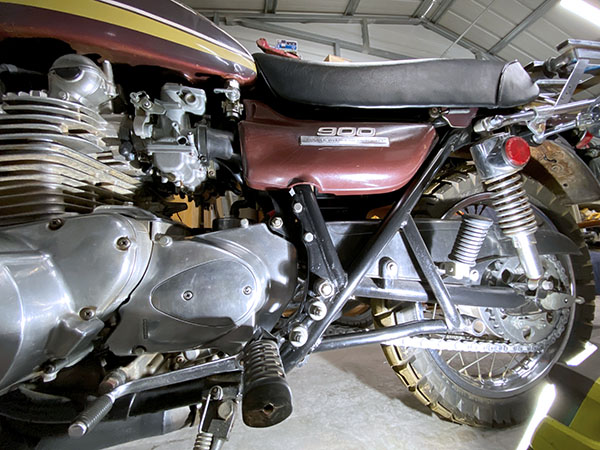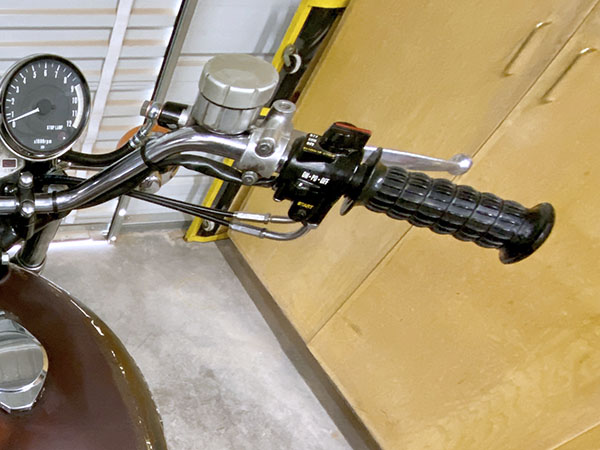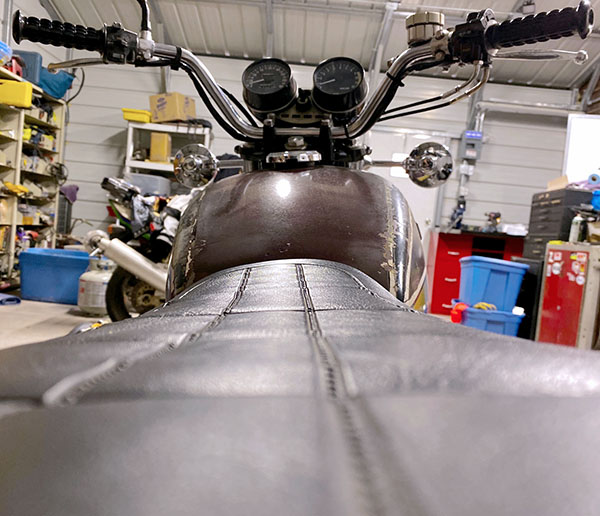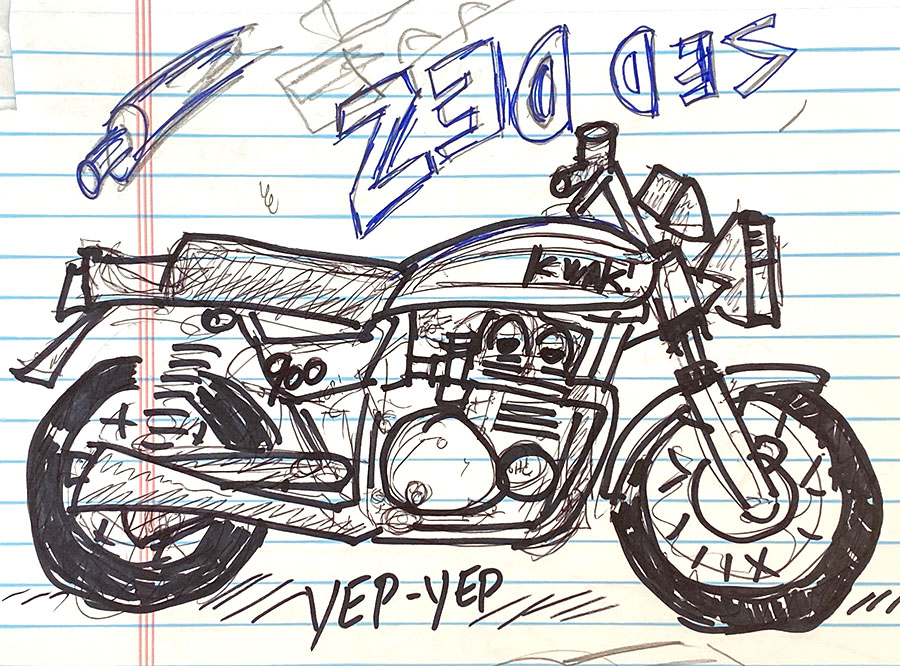The Kawasaki 900 is a legend amongst savvy motorcyclists around the world. Back in the day the limited-to-paper Moto Press lavished high praise on Kawasaki’s top of the line motorcycle. They even called it the King of Motorcycles. And the praise was well deserved. On any greatest-list the Z1 pops up as one of the best motorcycles ever built. But what’s it like to ride today? How does it compare to modern bikes with their liquid cooling, fuel injection and zillions of horsepower?
As it turns out, not too bad. The first thing you’ll notice is the power. Or lack of power compared to a modern Ricky-Racer type of motorcycle. The Z-1 is fast but in a leisurely way. The revolutions build slowly through the gears allowing a rider time to enjoy the acceleration process. There are only 5 cogs in the smooth shifting transmission but you get to enjoy each one of them for a few seconds before going on to the next. With less than half the horsepower of a modern 1000cc motorcycle the Kawasaki Z1 has a human-scaled power delivery. You don’t need the vision or reflexes of Valentino Rossi to wring the neck of this willing old battlewagon.

There are plenty of options available to increase the Z1’s horsepower to near-modern levels but I don’t feel like the bike needs more power. The Z1 is plenty fast enough to keep up with today’s traffic situations and unless you plan on improving the brake system you really don’t want this old Kawasaki going any faster.

The brakes are where you feel the weight of all those years that have scrolled past since 1975. The brakes are not good. The single disc, single piston front brake is the culprit. It takes a healthy squeeze to lock the front wheel and the brake lacks the precise feel of a modern multi-piston caliper. The rear drum brake is better at its job than the front brake but that’s only because rear brakes have much less influence on stopping. Antilock brake systems for motorcycles were unheard of when the Kawasaki 900 was made and you won’t miss it. I say all this for informational purposes only. It’s not like you can’t enjoy the 900 on a ride or you’re fearing stop signs. In regular use the brakes are borderline but acceptable.
A big surprise is how well the Z1 handles. When the Kawasaki first came out most moto-magazine reviewers praised the handling or at worst didn’t complain about it. Since then the un-illuminati have managed to change the narrative. Today the general consensus is that the Z1 is a widow maker, a bike with a hinge in the middle. Unsafe at any speed. I call BS.
The Z1 has a wonderful, lightweight feel through corners. The wide handlebars help with the easy steering. Large diameter wheels may also contribute to the stable, enjoyable ride. Leaned over the Z feels planted and neutral as long as you don’t hit any mid-corner bumps. On straightaways at speed the bike does not wobble. My Z1 has 45-year-old shock absorbers and so an upgrade might help but I’m not going that fast anyway.

This whole, canyon carving, race bike for the street thing has gotten annoying and probably explains the popularity of adventure motorcycles. Riders who blitz around on public roads feel like they’re really hauling ass but that’s because they are the only ones racing. Everyone else is just out for a ride. I get it: it’s hard to keep a 170-horsepower motorcycle under the speed limit or anywhere near it.
Marc Cook, an editor I worked for, once told me the 200 horsepower 1000cc BMW sport bike would be unrideable without all the electronic nannies. Modern bikes have gotten much better than modern riders. That’s where the human-scale power of the Z1 shines. You can whack it open without activating any rider aids because there are none because the bike doesn’t need them. Traction control for the Z is in the right twistgrip.

The Z1 is a mostly comfortable bike to spend the day on. Those high, wide bars that make steering so easy work against you at high speeds. If it didn’t mean replacing the cables and hoses I’d lower the bars a couple of inches but leave them wide. The big, long, cushy seat on the Z1 is a marvel of comfort. I slide way back for fast highway touring and scooch up tight to the gas tank in the twisty stuff. The mid-bike foot peg location is a good compromise and suits the Z1’s multipurpose nature.

Since the Z1 engine is a non-counterbalanced, inline 4-cylinder bolted solidly to the frame some vibration is transmitted to the rider. Personally, I love the way it moves but everyone has their own level of vibration tolerance and the quality of the vibrations changes with different engine layouts. The Z1 is smooth up to 4000 rpm. Above 4000 the vibration takes on different shapes and affects different areas of the motorcycle. None of this is very strong or detracts from the ride. There’s a sweet spot around 4700 to 6000 RPM where the Z1 feels as smooth as it needs to be. I wouldn’t call the Kawasaki a buzzer but if you were to jump onto the Z1 from your modern bike you may think the old Kawasaki is kind of raw. I think of that rawness as being alive with possibilities.

Fuel economy on the Z1 is so-so. I average between 38 and 40 miles per gallon but live at high-ish altitude and it’s been very hot. Heat and altitude kill mileage. I will check again in cooler weather when I expect a slight improvement. Fueling, the way the bike responds to throttle input, is slushier than an injected motorcycle. There are no abrupt engine responses. Things happen slightly slower right off idle but that may be my carburation setup. At a steady cruising speed the slushiness means you don’t need to keep strict control over the throttle. This bike is not nervous or skittery.

You’d think parts would be hard to come by for such an old motorcycle, but no. There’s a thriving Kawasaki Z1 restoration movement afoot. It’s mostly driven by demand, as the Z1 is commanding a premium price in the vintage motorcycle market. The Z1 is right at home in the middle-aged, empty-nester-loaded-with-cash, nostalgia-boomer’s wheelhouse. That demographic has and generates the most dollars. It’s actually easier to get parts for a 1975 Z1 than many more recent models and the prices aren’t unreasonable. With an abundant supply of repair parts easily obtainable the Z1 scores high for livability.
Compared to a modern 1000cc motorcycle the Kawasaki Z1 is slower, takes longer to stop and is worse in tangible ways. On a racetrack, that is. In ways intangible the Kawasaki Z1 is the better street motorcycle for simply enjoying a motorcycle ride. It’s easy to fix, reliable as any new bike (maybe more reliable) and a joy to possess.
I never feel like the Z1 is tolerating my incompetence. Instead we work together, both of us not in our prime, and we get places, you know? Riding Kawasaki’s Z1 feels like springtime and affirmation and young, anxious wonder. The bike is a time machine that radiates happiness. And when we get to the place we were going milky-eyed old men walk up and tell me how wonderful my motorcycle is and how much they loved the one they owned back when they were strong. That kind of reverence and emotion is not going to happen with just any motorcycle. The Kawasaki Z1 900 is much more than a collection of parts assembled in a factory. It’s industrial art that inspired an entire generation of motorcyclists. Long live the King!

Check out Gresh’s Kawasaki Z1 resurrection here!

